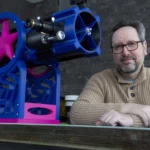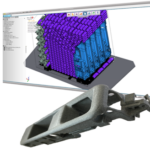The U.S. Army DEVCOM Ground Vehicle Systems Center (GVSC) has partnered with U.S. Army TACOM and SAE Government Technologies to open an Advanced Manufacturing Commercialization Center (AMCC) in Michigan.
The center will house the Army’s Jointless Hull subsection tool, a hybrid metal additive manufacturing machine used for engineering development and production to support the full-size Jointless Hull machine located at Rock Island Arsenal – Joint Manufacturing and Technology Center.

The full-size machine will be capable of producing large metal parts such as monolithic hulls for military ground vehicles. The Army aims to leverage this technology to manufacture parts more efficiently, reduce weight, lower costs, and improve long-term sustainment efforts, all to improve Army readiness.
“There are a lot of big, heavy metal parts within the Army inventory that additive manufacturing is not even an option to make simply because they don’t fit within the build envelope of the current machines available in industry,” said Christopher Spangler, GVSC Materials Division Advanced Manufacturing Branch Chief.
“This new machine will provide Rock Island Arsenal with an additive and machining capability that doesn’t exist anywhere else to not only produce parts for the Army but also across the DOD,” Spangler said.
The GVSC’s subsection tool can produce parts up to 3 cubic feet in size and will be used for development work to support the larger machine at Rock Island Arsenal. The ability to produce monolithic hulls is important, as they offer advantages in survivability and weight savings, but traditional manufacturing processes are not cost-effective or adaptable to full production, especially when multiple vehicle platforms are considered.
Advanced manufacturing, including additive manufacturing, has the potential to reduce the logistics burden throughout the force by enabling the capacity to build replacement parts on-demand. The new machine will also have the capacity to build and machine much larger additively manufactured parts than currently possible.
Ultimately, this project aims to improve the complete manufacturing process and supply chain for large metal subsystems, enabling additional advancements through the additive manufacturing process combined with materials and design to improve performance.
Come and let us know your thoughts on our Facebook, Twitter, and LinkedIn pages, and don’t forget to sign up for our weekly additive manufacturing newsletter to get all the latest stories delivered right to your inbox.









